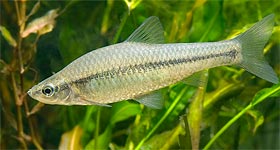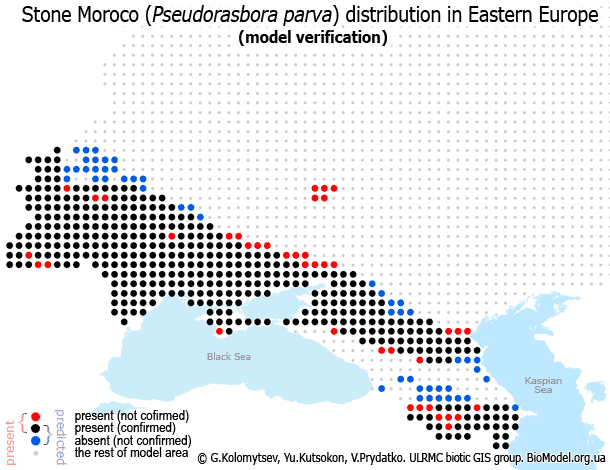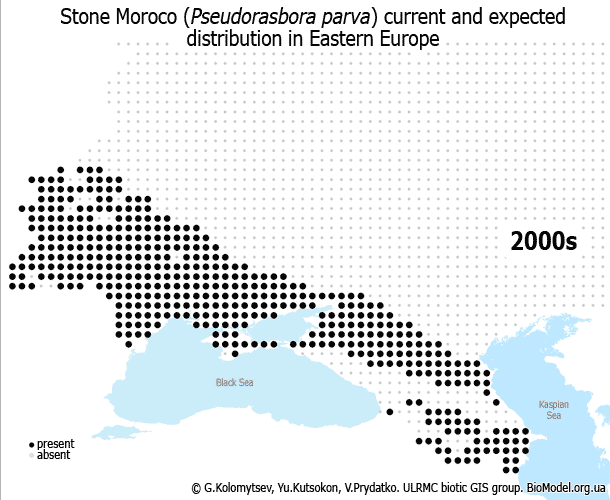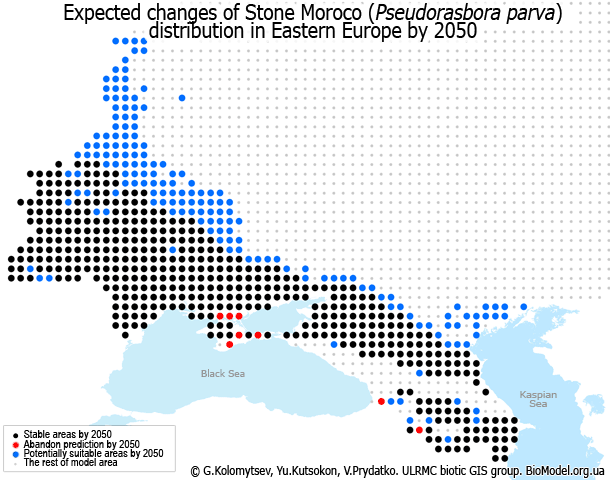Stone moroko
Pseudorasbora parva Temminck & Schlegel, 1846 (Cypriniformes, Cyprinidae)
 SYNONYMS
SYNONYMS
Fundulus virescens, Leuciscus parvus, Micraspius mianowskii, Pseudorasbora altipinna, Pseudorasbora depressirostris, Pseudorasbora fowleri, Pseudorasbora monstrosa, Pseudorasbora parva parvula, Pseudorasbora parva tenuis, Pseudorasbora parvus
Common names: Stone moroco, topmouth gudgeon, false razbora (GB), Blaubandbarbling, Amurbarbling, Pseudokeilfleckbarbe, Asiatischer Grundling (DE), Bandgrundling (DK), Ebarasboora (EE), Rytinis gruzlelis (LT), Amuras cebaceks (LV), czebaczek amurski (PL), Tschebatchek, Cebacok amurskij (RU).
Stone moroko is a fish belonging to the Cyprinid family, native to Asia, but introduced and now considered an invasive species in Europe. The fish’s size is rarely above 8cm and usually 2 to 7.5cm long. Minimum temperature for reproduction is 15-19oC.
Native range The native range of P. parva is the East Asian subregion including the basins of the rivers Amur, Yang-tze, Huang-ho, Japanese islands (Kiusiu, Sikoku and the southern and central parts of Honsiu), western and southern parts of the Korean Peninsula and Taiwan (Minkiang river system). In Europe it was first recorded in 1961 from southern Romania and Albania. In 1972 the species was recorded from the European part of the former USSR – the Danube delta and Dniester. In slightly over 40 years it has almost entirely colonised Europe, proceeding rapidly from east to west, including Hungary, Czechoslovakia, France, Austria, Germany, Belgium, the Netherlands, Bulgaria, northern Greece, Turkey and the western part of the Balkans, Poland, Italy, England and Denmark.
BioModel team developed SDM of P. parva to assess potential impact of forecasted climate change on it’s invasion in Eastern Europe by 2050. The modern P. parva distribution data and IMAGE model climate datasets were used as input. The climate data consists of actual records and forecast by 2050 in accordance with baseline IPCC scenario. SDM was developed using Generalized Linear Model (GLM) approach.

P.parva distribution model (Eastern Europe) shows expansion of this fish towards North-East by 2050. It is expected that distribution area of P.parva in Eastern Europe will increased by 40% comparing to current situation. New suitable areas are expected to appear near Lake Ladoga to the north of model area and within estuary of Ural River to the east.

Bibliographical reference – how to cite:
G.A. Kolomytsev, Yu.K. Kutsokon. Assessing of climate change impact on distribution of stone moroco (Pseudorasbora parva) in Eastern Europe by 2050, Kyiv – 2012
Коломицев Г.О., Куцоконь Ю.К. Поширення амурського чебачка (Pseudorasbora parva) в Східній Європі в умовах прогнозованої зміни клімату до 2050 року // Науковий вісник НУБіП України. Серія: біологія, біотехнологія, екологія. – 2012. – Вип. 178 – C. 9-15.
Kolomytsev G. (2012). BioModel – Species profile – Pseudorasbora parva. – From: BioModel – https://biomodel.info/species/stone-moroko-pseudorasbora-parva/, Date of access x/x/201x.

References
Карабанов Д.П. Экспансия амурского чебачка, Pseudorasbora parva (Temminck et Schlegel, 1846), в водоемы Евразии / Д.П. Карабанов, Ю.В. Кодухова, Ю.К. Куцоконь // Вестник зоологии, 2010. – Т. 44, №2. – С. 115–124.
Witkowski, A. (2006): NOBANIS – Invasive Alien Species Fact Sheet – Pseudorasbora parva. – From: Online Database of the North European and Baltic Network on Invasive Alien Species – NOBANIS www.nobanis.org, Date of access 29/03/2012.
Panov V. (2006): DAISIE – Delivering alien invasive species inventories for Europe – Pseudorasbora parva – DAISIE species fact sheet www.europe-aliens.org Date of access 29/03/2012.



0 Comments